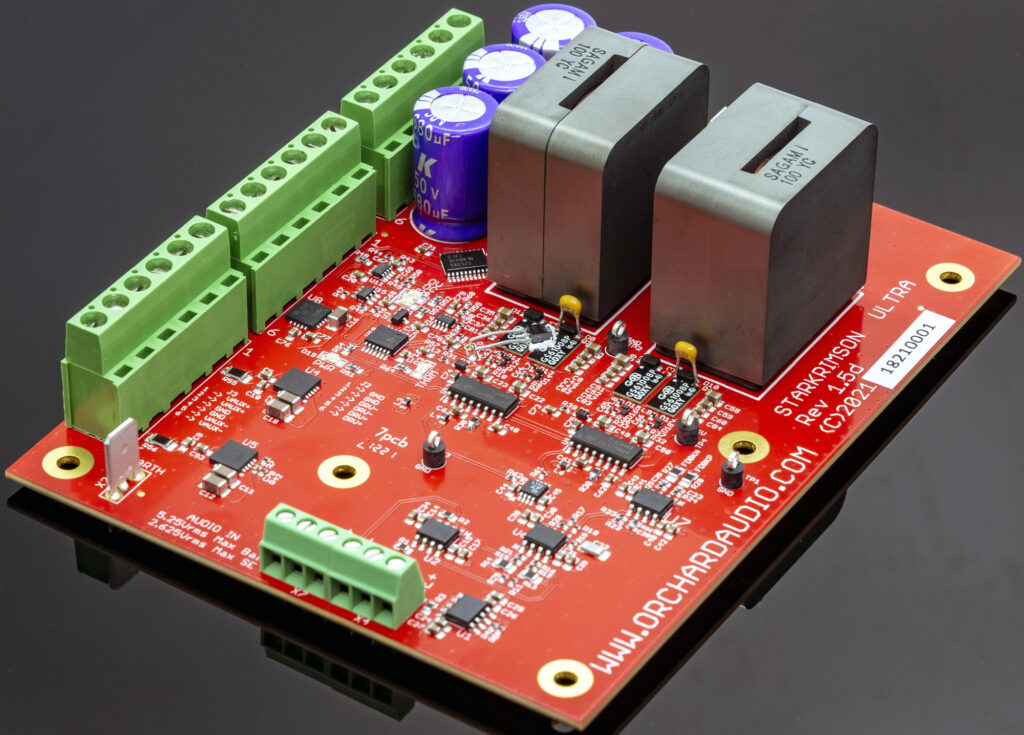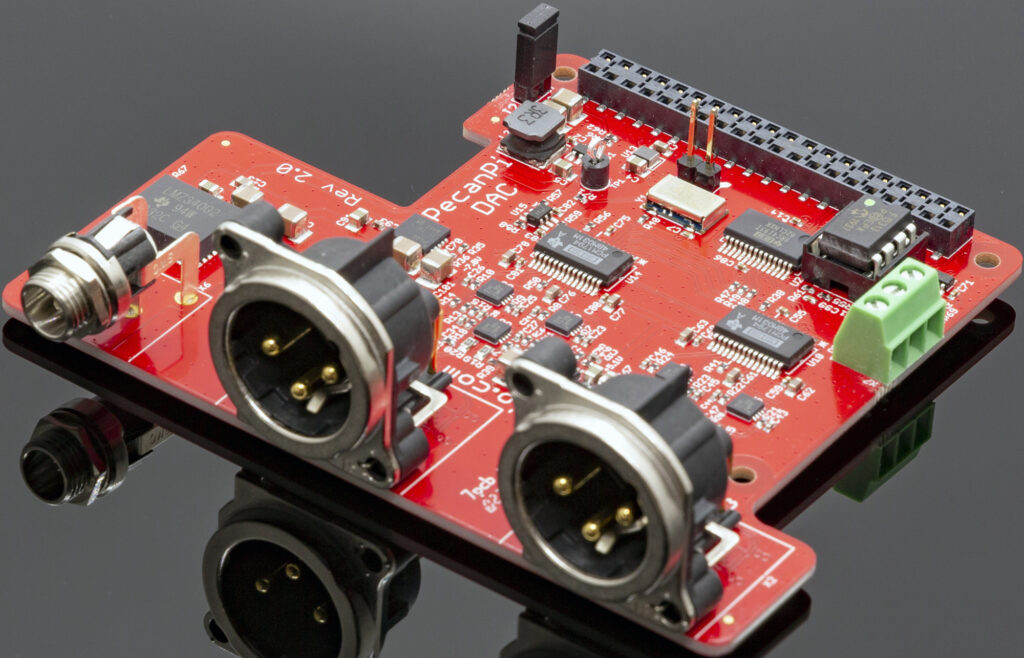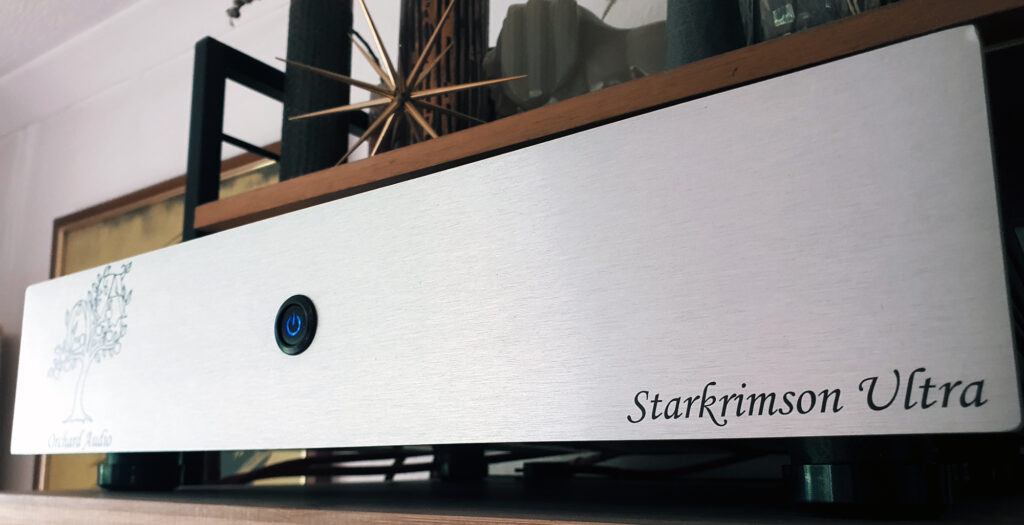On Chris Jones’ Roadhouses & Automobiles, there’s a cricket chirping throughout the piece. I can hear this through most of the track on my better setups, but it does fade in and out. Not so with the Starkrimson Streamer Ultra, where it was present from start to finish. Its resolution and microdynamics are equally matched by headroom and jump-factor. The transition from “Round Dance of the Princesses” to Infernal “Dance of King Kastchei” on the Atlanta Symphony’s 1978 classic performance of Stravinsky’s Firebird Suite can be startling on any capable system. The explosive attack with the streamer driving my Carrera 7 BEs left me gobsmacked. There was no hint of overload or distortion, and the echo trails and hall reverberation went on and on, extending further into the soundstage than I thought possible with this old digital recording.
Inside, we find that the Starkrimson Streamer Ultra is built from a few component boards that Orchard Audio offers separately to hobbyists, plus a Hypex SMPS1200A100 power supply and Hypex Softstart module. Point-to-point wiring connects the PecanPi DAC board to the inputs of two matched Starkrimson Ultra Mono amp modules. A Raspberry Pi 3 Model B/B+ is tucked away under the DAC board and fitted with a microSD card that’s been preloaded with RoPieee, a popular Roon endpoint solution. Although Roon, by far, offers the best experience with this streaming amp, customers may select Volumio at the time of purchase if they desire. Other ordering options include:
- Upgraded power rail capacitance (improves transient response and distortion performance at power levels above 50W by keeping the power supply rails more stable)
- Choice of color for the front panel
- Extending DAC outputs to the rear of the chassis for subwoofer integration
- USB port for connecting external storage (for use with Volumio)
- Regional options for line voltage and power cord
During listening via Roon, one must use Roon’s DSP Volume feature to manage playback levels because there is no remote control or physical volume knob. Initially, I found this a bit disconcerting because DSP Volume seemed to downgrade Roon’s signal path from “Enhanced” or “Lossless” to the green dot, indicating merely “High quality.” However, my mind was put at ease after reading a whitepaper published by Dr. Carl-Werner Oehlrich, author of several useful Roon extensions, including rooExtend and rooDial. In it, he explains that Roon’s implementation of DSP Volume has a lower noise floor and better channel tracking than virtually any XMOS or analog volume pot. I certainly did not hear any deleterious effects on sound quality while using the Starkrimson Streamer Ultra. Therefore, I advise you not to worry about that tiny green dot in Roon’s control apps.
Returning to how this streaming amp delivers on experiences, I found that picking up my phone to skip a track or tweak the volume pulled me out of the music. Remaining in that blissful semi-conscious state that accompanies longer listening sessions requires an interface that one can operate with eyes closed. The latest release of Roon enables the physical volume buttons on most smartphones and tablets to control levels for the active zone. While I found this helpful, the experience left much to be desired.
I purchased a Microsoft Surface Dial (about $70 at Amazon) and a one-year license ($12) for Dr. Oehlrich’s rooDial extension to address this issue. Because the Surface Dial is a Bluetooth device, and Roon is a networked system, the solution requires a Raspberry Pi to act as a Bluetooth to network bridge. Dr. Oehlrich suggests the $10 Raspberry Pi Zero W, but an old Raspberry Pi 3 Model B+ that I had lying around worked fine.
Having a gorgeous physical dial within easy reach of my listening chair was a game-changer. Play/pause/skip functions are managed by pushing on the top of the Dial: once toggles play/pause, twice skips forward, and three times skips back. Long press, like the other actions, is configurable. I set mine to toggle shuffle, but other options include stop playback and mute. With the Dial in the system, I queue up music for my evening listening sessions, then leave my smartphone and all of its distractions behind. One press on the top of the Dial and the sound of music takes me on a journey through time and space, restoring my mind and relieving the stress of the day.
What amazes me is how the Starkrimson Streamer Ultra can deliver such excellent results with minimum fuss. Early in my journey towards achieving great synergy between source and amplifier components, I learned that matching the impedance of inputs to outputs is essential. In his streaming amp, Leo has achieved what sounds like the perfect balance. There’s no need to obsess over swapping cables and components, as audiophiles from my generation tend to do as part of the rituals and enjoyment of this hobby. Leo is taking us old-timers to school, offering better synergy than most of us will ever achieve while providing a solution that delivers unforgettable experiences to those who will appreciate its simplicity.
Q&A with Leo Ayzenshtat
David: Was there a particular moment or experience that launched your journey as an audiophile? What would you say is the origin of your passion for great sound?
Leo: When I worked at Siemens, I had to design a DAC and amplifier for a fire alarm system. In Europe, fire alarm systems are also used for background music. After that design I thought, why not make an audio system for the house? As friends and guests visited and remarked on how good the audio system sounded, I had thoughts about commercializing it. Orchard Audio was launched in 2017 with the idea that great sounding products do not need to cost many thousands of dollars.
David: What was the first audio component that you built, and why did you decide to build it?
Leo: The first one would have been a DAC for that Siemens audio system; it was based on the TI TLV320AIC3104 codec/DAC. For my home audio system, I searched and searched for a great audio system at a reasonable price. Not finding this combination anywhere, I set out to design it myself. We should not have to break the bank to enjoy great audio quality. I ended up using the PCM1794A Burr-Brown (TI) DAC as the foundation. I have since tweaked and modified the design to what it is now – PecanPi® DAC.
David: Where did the name “Orchard Audio” come from?
Leo: My love of apples. My products are all named after things that grow in orchards.
David: I think it’s fair to say that your Starkrimson® Streamer Ultra and other products are more than the sum of their parts. What design philosophy or priorities did you apply to achieve such great measured and audible performance?
Leo: Leonardo da Vinci summed it up perfectly: “Simplicity is the ultimate sophistication.” The fewer parts you use in the audio path of devices, the less noise and distortion is introduced. My main goal is to achieve very high levels of measurable performance, which I believe will translate into objectively good results. This is also the reason you will not see too many features in my products. My focus is on audio and keeping prices as low as possible.
David: Unlike many other DACs, your design does not make use of filters implemented via XMOS microcontrollers. What would you say are the advantages and disadvantages (if any) to your approach?
Leo: As with my design philosophy that I alluded to earlier, I believe simpler is better.
David: Why is the gain so low on your Starkrimson® amplifier modules? What are the advantages to this design?
Leo: Advantages are twofold:
- The noise from input devices (DAC, pre-amp, etc.) will be amplified less.
- Having a lower gain in the amp means that the device that is driving the amplifier will be using a higher output level. This increases the overall dynamic range and SNR performance of the whole system.
David: What other products are you considering adding to the Orchard Audio family?
Leo: I am doing research into creating a multichannel (8-Ch) DAC.
I listen to and consider all customer feedback, and welcome any additional suggestions.
Copy editor: Dan Rubin
- ← Previous page
- (Page 2 of 2)



